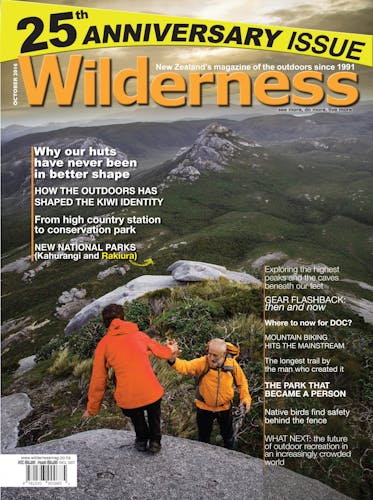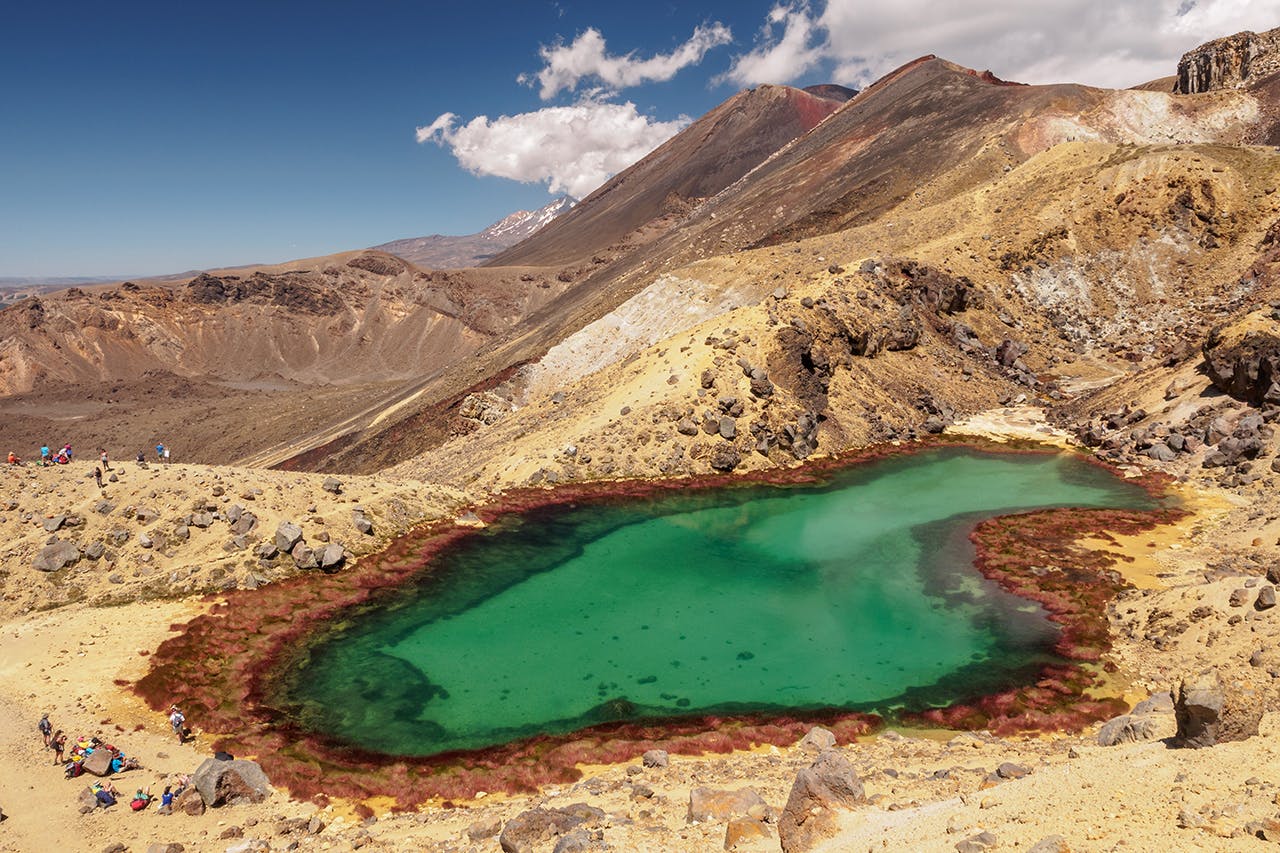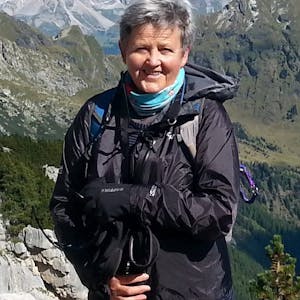What might the outdoor experience look like in 25 years? At the recent Sustainable Summits Conference at Aoraki/Mt Cook, outdoors people from around the world came to share ideas and solutions for some of the pressing outdoor issues of our time: overcrowding, access, human waste, melting glaciers and mountains that are falling down before our eyes.
Carry-in, carry-out
An explosion in tourists led to many facilities being overrun last summer. Reports of toilet waste beside tracks, near lakes and huts abound. Is the solution for everyone to carry out their own waste?
They’re doing it on Denali, on Everest and in Aoraki/Mt Cook National Park. Is it time to look more at packing our own waste out of the mountains, as technology improves the ways and means to do so?
Climbing environmentalists at Sustainable Summits conference held at mt Cook in August told how the costs of sewage systems in crowded mountain parks; the environmental issues (yes, tests show that stuff does travel down crevasses, through glacial ice and emerge, with pathogens, in rivers below) and cultural considerations inspired them to find ways to ‘clean up’ their mountains.
Roger Robinson, from Alaska’s Mt Denali National Park, has devoted decades to ‘clean climbing’ concepts. He developed the ‘Clean Mountain Can’, a portable toilet now embraced by the Denali climbing community, along with a composting system to treat the waste that’s packed out. Full ‘pack-out’ of all human waste is now mandatory in designated areas of the Alaska Range.
Dawa Steven Sherpa, managing director at Asian Trekking and an Expedition Operator’s Association Nepal board member, told the conference about getting Sherpa and climber buy-in to clean up Everest.
“I thought it was a damn shame the most famous mountain in the world also had a reputation for being the dirtiest. I saw Sherpas going up the mountain, setting up camps and coming down empty. So I suggested, if you find trash on your way down, bring it down to base camp and I’ll weigh it and pay you. Everyone joined in, for the Sherpas it was an opportunity to make a little extra cash.
“Then I had a really bad experience, while sharing a tent at Camp Two. The ice melted around us and it started to smell. We realised we had camped right on an old toilet site.”
This, plus a meeting with Robinson, inspired Dawa to encourage expeditions to pack out their human waste. “We give each of our climbers their own toilet bag before they leave base camp. We put their name on it so they can’t hide it away, though some are still quite sneaky.”
He said he did have apprehensions introducing the Sherpas to the practise because of cultural norms. “However, to us Everest is a holy mountain, we pray before we climb it, so we don’t want to leave our waste on it. As one of my Sherpas said, before we were carrying it up, now we are also carrying it down.”
Other groups are now using Clean Mountain Cans, he says. “It is catching on and the Nepal Mountaineering Association is looking to make it legal for all climbing teams to use toilet cans.”
In Aoraki/Mt Cook National Park, ‘poo pots’ were introduced 10 years ago, in particular for climbers and ski-tourers camping at high altitude or using huts in winter, when the toilets are covered with snow. The combination cornstarch bag and pot has about a two-day capacity, and waste can be disposed of at the village dump station, says Aoraki/Mt Cook visitor centre manager Lynne Woods.
“There has been some uptake of the pots, and other park visitor centres have asked for them. We’d actually like to broaden the use to freedom campers. We’re also looking at new technology, for example a product that uses granules to break down the solid waste.” Some student and defence force groups visiting the park bring their own ‘poo tubes’, she adds.
Meanwhile, waste management at huts and on increasingly crowded tracks was a challenge facing DOC. To counter the costs of flying waste out, ‘vermicosting’ methods were being trialled, said DOC waste management ‘guru’, Tom Hopkins.
Maori culture has become a major influence in waste management, in particular in areas of special cultural significance, added environmental engineer, John Cocks. “For example, all waste is flown out from huts on Aoraki/Mt Cook and around Lake Waikaremoana,” he said.
DOC technical advisor, Dr Harry Keys, said considering cultural values was a significant factor when siting new toilets on the Tongariro Alpine Crossing, where growing queues to the few toilets, and deposits alongside the track have become a huge, detrimental issue.
He said DOC planned to add 16 new pans (each comprising four toilets) over the next two summers on the Crossing, including one near the track summit at Emerald Lakes.
Keys said culturally there was a sense there should be no toilets above the line of the original gift, in 1887, of the mountain peaks to the crown. “It’s been a dilemma.” However, support had come from iwi, acknowledging that no one wants people to be “going everywhere” and leaving human waste in that special place.
“We are committed to flying out 100 per cent of the waste, although then people complain about helicopter noise and fuel use. It’s that or smelly, inadequate toilets. You have to have priorities. We are also looking at composting, or solutions to separate liquid from solids and reduce the volume to be flown out,” Keys said, adding that composting is difficult at altitude.
What about people packing it out, Denali-style? It would be difficult, said Keys. “However, before the conference I thought any system of packing out human waste was impossible. Now I’ve learned that it’s possible.”
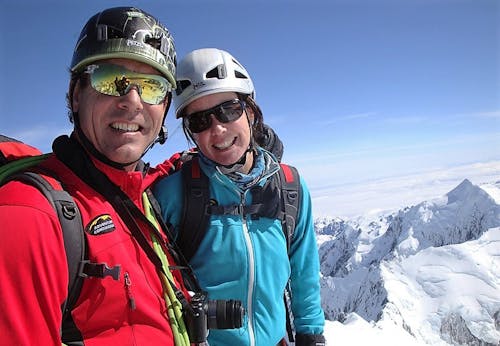
Guy Cotter and Suze Kelly say tighter regulation might be needed to manage growing tourism numbers. Photo: Supplied
A crowded house
Tighter regulation of our national parks might be needed if we’re to avoid being crowded out
Great Walk bookings are frenetic; Tongariro, Lake Angelus, Mueller Hut and Rob Roy Glacier are under siege. And we’re not the only place under pressure. At Sustainable Summits, learning how crowded mountain areas worldwide are being managed (or aren’t) provided food for thought.
Let’s start at the top, Everest, where trekkers and climbers converge at Base Camp and, on the mountain, bottlenecks at key points create dangerous situations. Dawa Steven Sherpa, Asian Trekking managing director, told the summit how the government called for solutions and the operators pulled together in response.
“Everyone has the same goal, to get to the top and back safely. We would go around base camp and note everybody’s expected summit date. Where there was a jam, say 250 people aiming to summit the same day, we would ask if some would shift dates. People were happy to shift, they don’t want delays, to use more oxygen.”
Dawa also mentioned a controversial proposal to put a ladder beside the Hillary Step, the vertical face near the summit that has become a notorious bottleneck. However, this might no longer be needed given an apparent collapse of the face as a result of the Nepal earthquake. Because of a heavy snow season since, it’s not yet clear exactly what has changed.
Dawa’s major concern now is the proposal to build a road to Base Camp. “It is going to have a huge impact. Everyone wants to go to Everest; with a road people can go any time of year. It will also bring down the cost.
“We have 38,000 trekkers a year now; goodness knows, that number could go tenfold.”
Fortunately, development is likely to be slow giving time to prepare for it, he added.
With her international expedition experience, Adventure Consultants’ Suze Kelly brought interesting perspectives to pressures facing our mountain areas. In particular, she spoke of Tanzania’s Mt Kilimanjaro, which she said can have anything up to 10,000 people on the mountain at any one time.
“You have to pay park fees to climb the mountain, you have to pay for guides, camp managers and cooks. The camps are clean, the toilets not so good. Yes the mountain is crowded, yet you feel in awe of the place. Never do you hear so much singing; there is a real sense of being in Africa. On balance the experience is positive.”
The conference heard how Europe’s Mt Blanc Range has no legal status. The area receives five million annual visitors, including more than 20,000 climbers trying to climb Mt Blanc, Europe’s highest mountain. Between them, two cable cars transport more than one million tourists to altitudes over 3500m. Scenic flights are rife. The main summit route is not technically difficult but there are two accident spots where people die each year.
Yet the region borders three countries, Switzerland, France and Italy, and there is no legal, protective status, says Olivier Moret, mountaineer and executive director of the Petzl Foundation.
“Guides cannot agree on a plan of action to mitigate risks. There are no serious safety solutions on the table. Pollution and waste are making huge impacts. In summer, aircraft fly over the range every 10 minutes making it difficult to enjoy your climbing and wilderness.”
He said Espace Mt Blanc, an agreement between the three countries to study sustainable versus economic growth in the range, was established in 1991. “It had no legal power, and today it feels like economic growth is in a winning position.”
In New Zealand, where we do have legal powers to protect our mountains and conservation lands, we also struggle with sustainability versus the economy, as Suze Kelly points out.
“Compared with most countries where I’ve led expeditions, New Zealand is really under-regulated. As New Zealanders, what we don’t want is to pay to go into our national parks. We belong here and we have a strong sense of ownership. But what about sustainability, and tourism growth? Perhaps we need a different mind-set. We need to find a model that fits for all.
“I think the Department of Conservation is responding well, trying to manage pressure points. However, DOC director general Lou Sanson said at the Summit that he was surprised by the scale of tourism growth. Yet Tourism New Zealand is still flat out marketing New Zealand and Air New Zealand is promoting the Great Walks.”
Sanson told the Summit how, two hours after bookings opened for the coming Great Walk season, all of January on the Milford Track was fully booked. Meanwhile, on the fastest growing Great Walk, Rakiura, numbers have more than doubled in the past five years.
‘I think our government departments need to be better co-ordinated. There is a lack of forward planning,’ said Kelly.
Adventure Consultants director, Guy Cotter, also expressed dismay at the lack of planning, along with the amount of marketing he saw going into promoting New Zealand. “Government needs to show some leadership here. We should build the foundation before we build the house.”
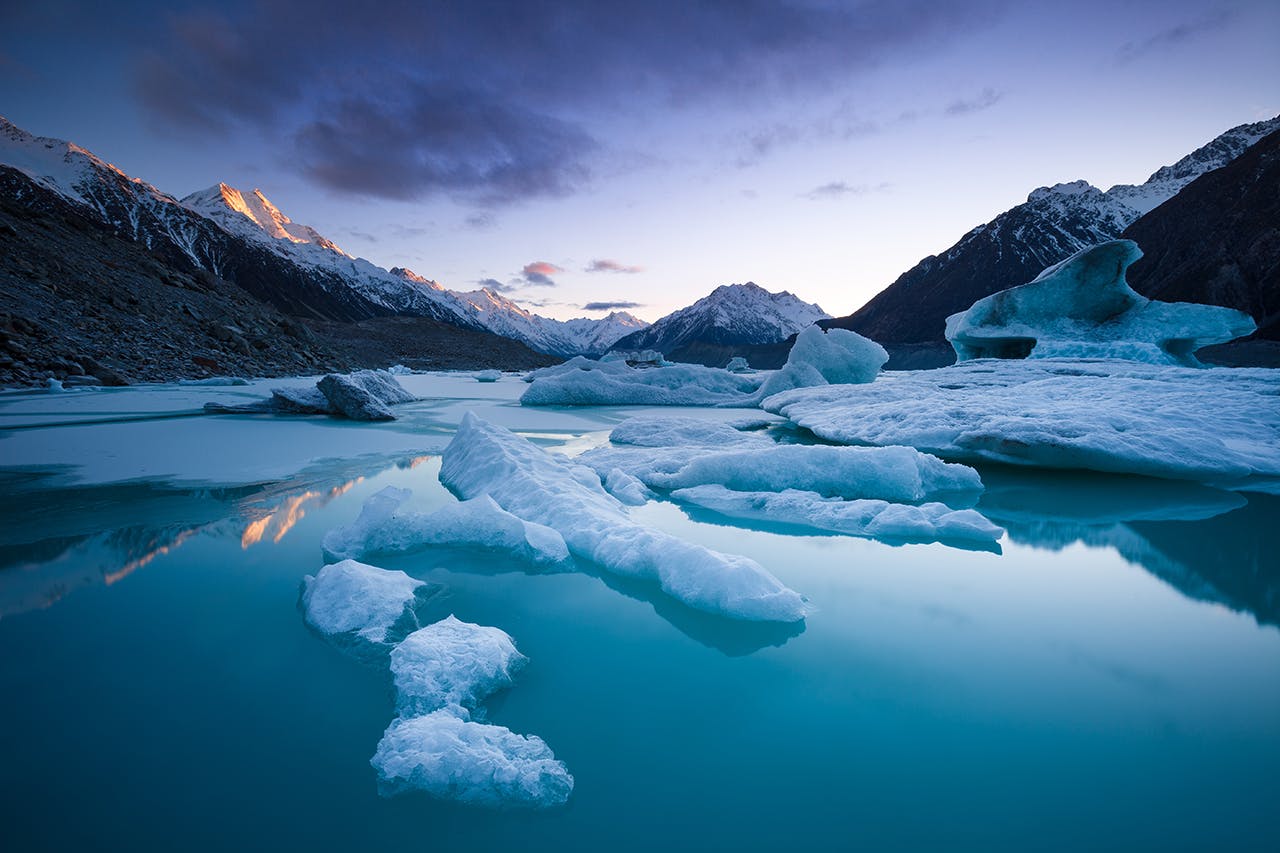
Melting glaciers create beautiful lakes like this at Tasman Glacier, but they also leave mounds of moraine which makes access to the mountains more difficult. Photo: Mark Watson
The mountains are falling
Crumbling rock faces and retreating glaciers may make some places inaccessible and too dangerous to visit
Our mountains are falling down at an exponential rate and development of our backcountry structures needs a new way of thinking, GNS Science Principal Scientist Simon Cox told those at Sustainable Summits.
“The frequency of rockfalls in the Alps has increased exponentially in recent years. Building huts as we’ve done in the past is fine in open low country, but in the high alps we need to change our psyche completely. We need to build structures that we can pick up and move as things get dangerous. And we need to build them with shorter life spans of 10 to 20 years, not 50 as we have been doing. The landscape won’t last 50 years.”
Cox said Gardiner Hut, which was flown out after being hit by a massive rock avalanche in 2014, was an example of DOC doing things well. It reflected the good design and placement that the hut had only been damaged, not destroyed.
When he first began climbing, Cox said he thought the mountains were eternal. Studying plate tectonics taught him otherwise.
“The Alpine Fault is pushing the mountains up around 5mm per year. It’s going to go ‘pop’. It’s happening now in lurches and bumps.”
Climate change is adding to the dynamics, he said. “There are huge rainstorms and erosion on the west coast.” Incidences of landslides, secondary collapses, lateral spreading of icefalls and slope avalanches are all growing.
“Mueller Hut, which has 3000 visitors a year, is sitting on the side of a very active landslide. Structures on alluvial fans are also in danger, with river channels jumping around and carrying huge boulders.
“We need a holistic view, considering all of the geological and meteorological hazards; this requires new thinking for management.”
Glaciologist Brian Anderson had messages for the summit about glacial retreat, visitor safety and global warming. He said Franz Josef Glacier has among the fastest melt rates measured anywhere in the world, while Fox Glacier has retreated 200m since 2014.
“As the glaciers are moving, the hillsides are crashing down, at the same time thousands of people are there visiting. It’s a real struggle to manage these sites safely.”
Similarly, Tasman Glacier Lake, which was visited by 40,000 tourists last year, is growing and has been prone to massive calvings of ice in the past three years. Anderson said the front part of the glacier is currently lifting up, one day it will break off and the glacier will lose about seven million tonnes of ice. “That’s kind of bad for the glacier and really bad if you’re on a boat tour on the lake.”
Even with a minimum two or 2.8 degree global warming, our glaciers are going to get really small, said Anderson. “The message I’d like to get across, if we really care, is we have a choice regarding our emissions profile. Whatever we do is going to make a big difference to our glaciers, even half a degree in difference is actually quite a lot. And that’s important nationally and regionally for our tourism, tramping and water resources.”





